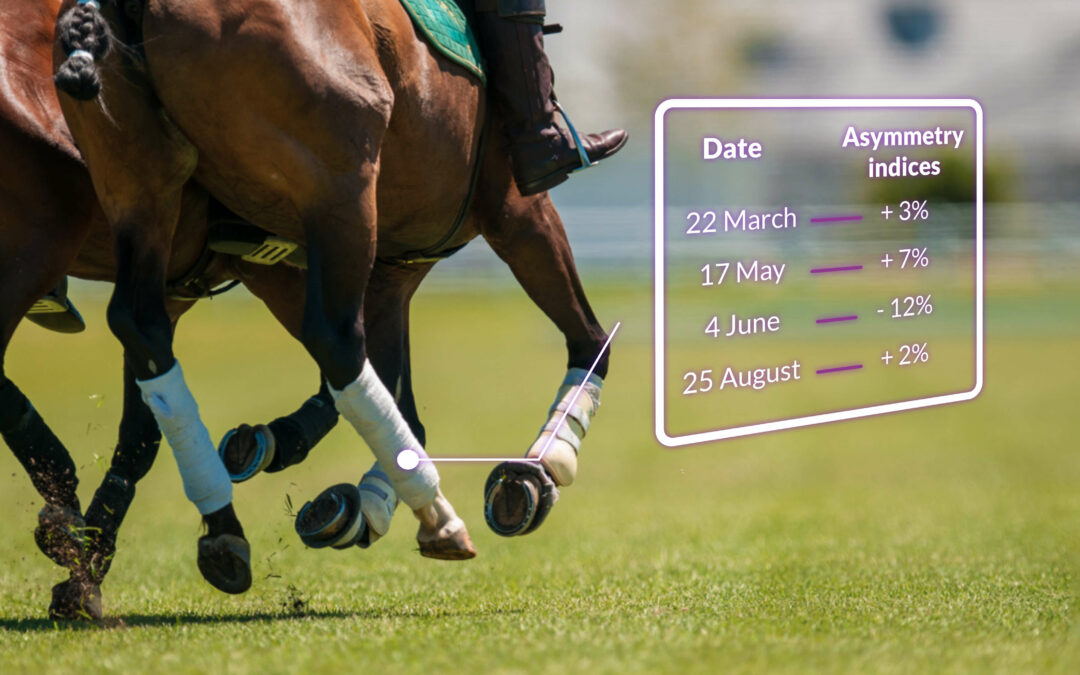Usually, a horse does not become lame in one day. However, it is often when the lameness is obvious and installed that the rider notices it, delaying the therapeutic treatment. Discover how and why to perform a longitudinal monitoring of the horse’s locomotion.
HORSE MONITORING AND PREVENTION
A healthy horse, depending on its locomotor preferences or physical characteristics, is one that does not feel pain or constraint in its physiological movements. Lameness occurs when these movements become painful or, less frequently, when dysfunctions of the locomotor system occur due to neurological or mechanical alterations. It manifests as symptoms ranging from simple stiffness to the horse’s inability to put its hoof down. There could be several reasons for this.
The severity of this manifestation varies greatly depending on the nature of the lesion and each individual’s pain tolerance. Lameness is not a disease but a symptom, i.e. the clinical manifestation of a condition.
The horse will attempt to relieve the pain in its diseased limb(s) by compensating. He frequently tries to shift his center of gravity to the healthy limbs. This adaptation may have an effect on the amplitude of the trunk’s vertical movements in relation to the painful limb. This asymmetry is visible throughout the horse’s movement and can be measured with sensors.
HORSE LOCOMOTION QUANTIFICATION TOOL USED TO ESTABLISH AN EARLY DIAGNOSIS
“[…] These systems were a valuable aid in the regular monitoring of horses, especially for sport horses. Clear objective results and subtle changes enabled preventive medicine.”
Longitudinal monitoring can be implemented by comparing multiple locomotion exams over time, using regular measurements of a horse’s locomotion. Asymmetry quantification tools enable the measurement of fine and complex variations, thereby preventing locomotion deterioration and the aggravation of a lesion. Major lesions are often restrictive in their treatment. They can be a real source of uncertainty and financial responsibility for owners, as well as a source of pain for the horses, who are usually subjected to more or less restrictive treatments and immobilization. The horse’s sporting ability should frequently be re-evaluated.
The purpose of this monitoring process is to facilitate the athlete’s follow-up in order to ensure his good health and well-being (prevention) and also to support the diagnosis. Indeed, the tools for quantifying equine locomotion are valuable aids for locating the painful area. For example, these tools allow the objectification of a subjective clinical evaluation of anesthesia impact by quantifying precisely the changes related to anesthesia.
Early detection of a discrete locomotion alteration in a healthy horse could lead to a better understanding of the etiology (causes) of the lesions and their appearance circumstances.
IDENTIFY THE ORIGIN OF LOCOMOTOR SYSTEM DISEASE
The locomotion quantification tool enables the collection of objective and comparable data at any time in order to monitor the evolution of the horse’s health over time. Using these tools as a preventive measure allows us to detect small changes and better identify the cause and circumstances of these lesions’ appearance. We could then trace their origins, detect early clinical signs, and treat them.
It is pertinent to use this type of system on healthy horses for comparative purposes on a long-term basis. The veterinarian can thus anticipate a potential deterioration, which, in the case of an athletic horse, could seriously affect its sporting career.
EQUISYM is simple to set up in any examination setting, both in the clinic and in the field. Many veterinarians can collect data on many horses, greatly increasing the potential study samples! Discover how to quantify asymmetries with EQUISYM.
MONITOR AND EVALUATE THE ATHLETIC HORSE’S REHABILITATION
Often, the diagnosis of a locomotor disease is not established until the lameness has set in. The horse is then treated and convalescence measures, which are often a source of expense and stress, are put in place depending on the type of injury and its severity. Following this, a more or less long rehabilitation is provided.
Owners are often powerless to deal with these periods of waiting and doubts, as they find it difficult to see any significant improvement.
Locomotor data collected during locomotor examinations with EQUISYM are processed by our algorithms and presented in a simple and intuitive way on the iPad application. Clients who are not familiar with locomotion analysis will be able to see improvements by viewing the examination curves superimposed on the data, along with the vet’s explanations. Furthermore, the veterinarian will be able to accurately assess whether the rehabilitation protocol needs to be adjusted based on the evolution of the locomotion over the course of days, weeks, and months.
Clients will be reassured to have visual support as they are often not able to see the locomotor subtleties identified by the clinician’s visual examination. This can strengthen the veterinarian-client relationship by reinforcing the client’s feeling of inclusion in the care of his animal. Because of a more accessible understanding of his horse’s locomotor evolution, the owner is integrated and actively participates in his horse’s rehabilitation.
CONCLUSION
Longitudinal monitoring of the horse athlete is a significant challenge for the improvement of veterinary medicine, whether for the management of locomotor diseases, their study or, most importantly, their prevention. To that end, new technologies provide precise and quantifiable data on equine locomotion.
Tools such as EQUISYM allow you to keep a record of examinations over time and compare them (for example, on different dates or before/after anesthesia). Because of the ability to monitor the horse athlete, it is easier to evaluate the variations, which can be subtle, that reflect the evolution of locomotion over time.
EQUISYM also allows the veterinarian to propose visual results to improve communication with his clients, who are thus more involved in monitoring the health of their horses.
Keywords: longitudianl monitoring, locomotor asymmetries, lameness, equine veterinarians, diagnosis


